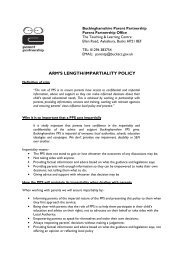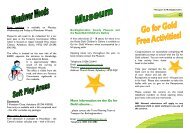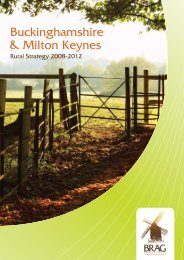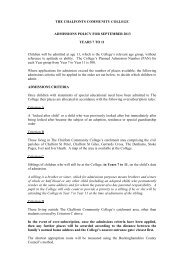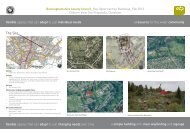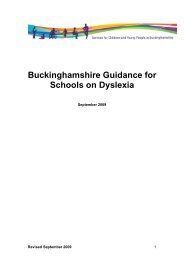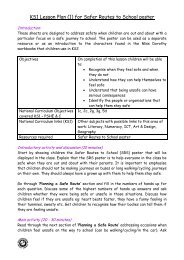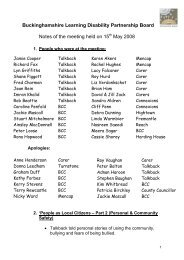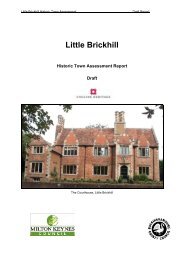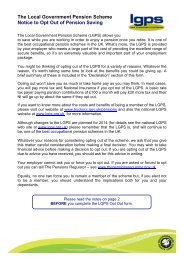Stroke Patient Portfolio (PDF) - Buckinghamshire County Council
Stroke Patient Portfolio (PDF) - Buckinghamshire County Council
Stroke Patient Portfolio (PDF) - Buckinghamshire County Council
You also want an ePaper? Increase the reach of your titles
YUMPU automatically turns print PDFs into web optimized ePapers that Google loves.
<strong>Stroke</strong> <strong>Patient</strong><strong>Portfolio</strong>For patients, their carers, families and friends
If this <strong>Stroke</strong> <strong>Patient</strong> <strong>Portfolio</strong> is found, please return to:If you have particular needs which make it difficult for you toread this document, please contact the Communications Teamon 01296 382 173
Page234689111819202126293035363940414243474951556768ContentsAbout your <strong>Patient</strong> <strong>Portfolio</strong>Your DetailsHealth and Social Care ContactsAbout MeAbout strokeAbout the brainThe effects of strokeSex and relationshipsDriving after a stroke or TIAWelfare Benefits you may be able to claimGlossary of TermsList of stroke factsheet information from The <strong>Stroke</strong> AssociationWarning signs of strokePreventing a strokeMy stroke risk factorsPersonal lifestyle assessmentAbout your MedicationMedication TableCommon medicines used in stroke careAbout your Personal Care PlanPersonal Care Plan sheetsYour services and supportAppointment ListCommunications PageUseful Contacts and ResourcesCarer InformationSuggested reading for stroke patients and their families1
Your <strong>Patient</strong> <strong>Portfolio</strong>¢ This <strong>Portfolio</strong> is to help you keep a recordof your care.¢ The <strong>Portfolio</strong> also provides information onstroke and how to look after yourself.¢ Contact details of useful organisations that maybe able to help you and your carer are also included.¢ You may find it useful to share your <strong>Portfolio</strong>with people involved in your care.¢ We recommend that you take it with you toall your appointments and treatments.¢ You can ask health and social care staff to recordinformation in your <strong>Portfolio</strong> whenever you feelit would be of benefit.¢ You may also wish to write in the <strong>Portfolio</strong> yourself,or ask friends and relatives to contribute.2
Your DetailsNameAddressTelephoneMobileEmailNext of Kin/Emergency ContactNameAddressTelephoneMobileEmail3
Health and Social Care ContactsDoctors and PharmacyName of GPName of PracticeTelephoneName of ConsultantYour NHS NumberYour Pharmacytelephone numberYour Physiotherapist isYourOccupationalTherapist isYour Specialist Nurse isYour Social Worker isYour Speech andLanguage Therapist is4
Your Hospital KeyWorker isYou can contact your Hospital Key Worker on the following number at thetimes shown:Your Community KeyWorker isYou can contact your Community Key Worker on the following number atthe times shown:Should you need help andadvice at the weekendplease contactOther involvedprofessionalsIf you feel ill, please contact your GP in the normal way, andfollow advice given by the surgery. In an emergency ring 999.5
The following section is for you to write information about yourself, your likesand dislikes and what is important to you. It is up to you whether you wish tocomplete this and how much information you want to include.Some people have found this helpful after a stroke particularly when meeting newstaff and professionals in the community.You may wish to include information on the interests and preferences you hadbefore you had your stroke and the ones you have now. Some of these may be thesame, but some may be different.You may also like to include information on your dislikes and what is important toyou for the people supporting you to understand.About meInterests and preferences before my strokeInterests and preferences since my stroke6
About meMy dislikesWhat is important to me7
About the BrainThe brain has two hemispheres (sides). The nerve signals(messages) cross over at the base of the brain, so a strokeoccurring on the right side of the brain will affect the left sideof the body and vice versa.¢ The main functions of the lefthemisphere are:-ß Speech and understandinglanguageß Reading and writingß Movement of the right sideof the body.¢ The main functions of the righthemisphere are:-ß Recognition of objectsßßßßßßFinding your way around placesRecognition of peopleAwareness of your own bodyPutting on clothesSensation on the left side ofthe bodyMovement on the left sideof the body.9
About the BrainThe brain is also divided into different lobes (parts), and the brainstem and cerebellum. Each of these areas is responsible for differentfunctions. The diagram below shows the right side of the brain. Theleft side looks the same but has slightly different functions. responsible for personality and controlof movement responsible for appreciation of sensation responsible for the understanding of sight,sound and touch sensations responsible for interpreting vision controls the vital functions of swallowing,breathing and the action of the heartresponsible for co-ordination of all musclemovements, including:- walking, talking,muscle tone and balance10
The Effects of <strong>Stroke</strong>It is important to understand that no two people are affected bystroke in the same way.The effect of a stroke on a person depends on which part of thebrain has been affected and how much damage has been caused. ¢ ¢ ¢ ¢ ¢ ¢ ¢ eg. being able to follow a tv programme or read a book.This could be due to the effect of boththe stroke and tiredness. It may behelpful to set yourself little goals youhope to achieve, or to set short timelimits for any activities you hope toperform. It is frustrating to set yourselfa huge task and be unable to completeit. It is therefore more sensible tobreak down the task into smaller, moremanageable steps. You will also be ableto concentrate much better on severalsmall tasks than one huge one. If youneed additional help you may be eligiblefor further occupational therapy.For tips on improving your concentration, there is a fact sheet availableon Cognitive Problems after <strong>Stroke</strong> from the <strong>Stroke</strong> Association(www.stroke.org.uk 0303 303 3100).11
The Effects of <strong>Stroke</strong> ¢ eg. remembering facts from the recent and distant past, as well as retainingthe ability of how to do certain tasks.Memory problems are common afterstroke. It may be useful to try andestablish a regular routine around dailyactivities. Try writing things down andhave several calendars and clocks on viewto remind you of the date and time.Use a diary so that you do not forgetimportant appointments or stickreminders in prominent places. You mayfind it helpful to use the AppointmentsList later in this <strong>Portfolio</strong>.¢ ¢ eg. where your arm is in relation to objects. You may bump intothings especially on the affected side.¢ eg. pins and needles, numbness or pain.¢ Sometimes stroke can affect vision. It can take time for your eyesight tosettle, so it is recommended that you wait six months after your strokebefore having your eyes tested.However, some problems can occuras a result of damage to those partsof the brain that help us to interpretwhat we see, even though the eye itselfmay be working normally. If you areexperiencing visual problems, pleasespeak with your GP or optician.¢ eg. you may have forgotten how to use them or are less coordinated.¢ eg. cooking a meal, making a hot drink whilst talking.12
The Effects of <strong>Stroke</strong> ¢ This is a speech disorder.Weak, stiff or uncoordinated muscles around the mouth and facial area canresult in poor speech control¢ This is a language disorder.Both aphasia and dysphasia are generally used to mean the same thing. Listening andtalking, reading, writing and using numbers can all be affected in different ways.There are ways to help someone with dysphasia/aphasia and these can be discussedwith the Speech and Language Therapist. It is often helpful to give the person timeand a quiet environment. Pictures, photos, gestures, drawing and writing can be usedto support speech and understanding. For more information on ways to help, see the<strong>Stroke</strong> Association leaflet called “Communication problems after stroke”. Page 26and 28 of this <strong>Portfolio</strong> explains how to access <strong>Stroke</strong> Association factsheets.There are 2 very helpful organisations who offer advice and supportfor patients and carers: Tel: 0207 367 0840 www.ukconnect.org Helpline: 0808 808 9572<strong>Patient</strong>s with communication problems may be offered speech therapy in thecommunity and in groups.¢ This is a physiological disorder where the swallow reflex can be affected.If you have difficulty swallowing, the Speech and Language Therapist may adviseconsistencies that are safer to swallow. Food may need to be pureed or a soft dietmay be recommended. Thickener may be added to drinks to make them easier toswallow safely. Recommendations for eating and drinking will be given by the Speechand Language Therapist after assessment.Warning signs for difficulty in swallowing can be coughing or choking when eatingor drinking. If you have concerns about swallowing, a referral can be made to theSpeech and Language Therapist by your GP.13
The Effects of <strong>Stroke</strong>Other issues which may occur following stroke are detailed below: There are many reasons why peopleexperience pain or discomfortfollowing a stroke and this is mainlybecause they are not as mobile as usual.However there is a pain known as centralpost-stroke pain (CPSP) which is quitedifferent. CPSP rarely starts straight aftera stroke. It is much more likely to beginseveral months after the stroke and maytake as long as two years to appear.A recent study showed that about onein eight people may have experiencedCPSP within six months of a stroke andanother study put the figure as one intwelve people. It is not known exactlywhy CPSP develops. It may arise from thebrain’s efforts to compensate for damageto the pain pathways. Instead of simplyrecovering normal sensation, it losescontrol of the mechanisms which regulatethe intensity of feeling.Sufferers often describe the pain asicy-burning, throbbing or shooting pain.There can be aching like toothache andeven light clothing brushing against theaffected area of skin is painful.The pain tends to be isolated in one partof the body, usually an arm or leg, and isalways on the side of the body affectedby the stroke. CPSP is not difficult todiagnose but doctors are not alwaysaware that it can occur after stroke. Asimple test is to check whether you cantell the difference between the feel of acold teaspoon and a warm finger on theskin of the affected area, or a sharp versusa blunt object. People with CPSP canfeel that there is something on their skinbut have lost the ability to differentiatebetween other types of stimulation.Conventional painkilling drugs, whichblock nerve impulses at the place wheresomething hurts, usually have littleimpact on CPSP because the injury isin the brain. However, low doses ofantidepressant drugs can be helpful forsome people. An anti-epilepsy drug,called gabapentin, has also shown to helpwith painful nerve problems. Speak toyour GP for more information.14
The Effects of <strong>Stroke</strong>It is not uncommon to experienceproblems regulating and controllingyour bowels and bladder after astroke. This may be due to damage inthe area of the brain which controls thebowels and bladder, or due to lack ofmobility. Constipation is common andmay be avoided by drinking at least 8glasses of fluid each day and increasingyour intake of fibre in the form of fruit,vegetables, cereals and wholemeal bread.Incontinence is a difficult topic to discussas it can cause embarrassment. It isalso assumed that little can be done toimprove the problem. This is untrue.Should you suffer problems with yourbowels or bladder, please do speak to oneof your team.Some medication (particularly forhigh blood pressure) may also makeyou feel tired. It is also the case thatolder people tend to feel more tired,along with those who felt tired priorto having a stroke. Sometimes medicalconditions such as diabetes can alsohave an impact. Do not stop taking yourmedicines without informing your GP.This can come on suddenly afterapparently little effort. It is very commonafter a stroke and could have a significantimpact on your well-being. Your brain isworking very hard to compensate for thedamage caused by the stroke, and thistiredness is normal. Often an afternoonnap helps to relieve the fatigue. Youshould not ‘work through’ the tirednessas this may make you wearier. You arenot lazy if you put your feet up! In fact,you are recharging your energy levelsto enable you to continue with your dayto day activities. Talk to the team aboutmanaging fatigue. These are very common afterstroke and can include anxietyand/or low mood. Emotional liabilityis when you have an unprompted anduncontrollable tendency to cry or laughat things whether it seems appropriateor not. Emotional changes are estimatedto affect about one in every four peoplein the first six months after stroke. Thecause of emotional changes is poorlyunderstood, but it is due to the strokeand is not easy to control. It often settlesas the person recovers but if not, antidepressantmedication can help. Talk toyour team for advice.15
The Effects of <strong>Stroke</strong> Many people who have had a strokeshow some change in personalityor behaviour. They may become lesssociable, more introverted, angry oraggressive. Often there is a completereversal of character. For instance, a mildmannered person may become aggressiveor a difficult person may becomemore passive. More commonly, existingpersonality traits are exaggerated.Damage to the brain can also result inloss of inhibition. Some people becomeconfrontational and are unable to preventthemselves from expressing unkind orinappropriate thoughts. The person isoften unaware of these changes; it is oftenfamily and friends who are most likely tonotice.If you do have problems with behaviouraland personality changes which are causingproblems with your relationships, youmay be able to get help from a numberof professionals, for example clinicalpsychology, psychiatry or counselling. Talkto your GP or key worker for a referralor refer to the ‘Useful Contacts’ towardsthe end of the <strong>Portfolio</strong>. At home you may not be able todo all the the things you did, forexample preparing meals, shopping,gardening. You may have lost your job orhad to change the type of job you do. You may find that you are limitedby mobility, speech and/or financialissues following a stroke.It can take a while to adjust to thepsychological, emotional and socialeffects of stroke.16
The Effects of <strong>Stroke</strong>Depression is common after strokein all age groups. It is estimated thataround half of those who have a strokeexperience significant depression at somepoint within the first year. Depression canbegin soon after the stroke or many yearslater, ranging from mild to severe.There are several reasons for this. Thephysical damage to the brain can triggerdepression by disrupting the electricalactivity, which generates and controlsemotions, perceptions and thoughts.Depression may also stem from a varietyof emotional reactions towards the strokeitself, such as the effect of any lastingdisability and the impact on your futurehopes and dreams. For many, depressionmay result from a combination of these.If you are suffering from two ormore of the following you maybe suffering with depression:Change in sleep patternChange in appetitePoor concentrationIncreased agitation or anxietyLoss of interest in activities youpreviously enjoyedLow energy or fatigue (althoughyou may feel this anyway followinga strokeLow self-esteem or feelings ofhopelessnessDepression is an illness, not a weakness, and it can seriously delay yourrecovery. There is much that can be done to help. Speak to your GP about medicaltreatment, which may include taking anti-depressants and, if appropriate, counselling orpsychotherapy. You will also find the details of organisations that can help in the ‘UsefulContacts’ section towards the end of the <strong>Portfolio</strong>.Depression can make you feel isolated and withdrawn. Talking to others can be a greathelp. If you are able to, keep talking to your family and friends – don’t push people awayor assume you are a burden. Meeting people regularly is an important weapon againstdepression. Try also to keep active if possible. Physical activity, no matter how gentle,can help lift your mood and also ease tiredness and fatigue.17
Sex and RelationshipsThe first few weeks followingdischarge from hospital can be avery unsettling time for both youand your partner or carer.To return home after a period in hospitalrequires adjustment for all concerned.The consequences of a stroke affect allmembers of the family; you may spendlonger periods of time with each otherand possibly with less sleep. Many peoplesay they find they argue more in the earlymonths after discharge from hospital. Tryand share your concerns and feelings witheach other as ‘bottling things up’ will onlyincrease your stress levels. Try and giveyourselves time to adjust. Often meetingothers in similar circumstances can help.Details of the <strong>Stroke</strong> Association andlocal stroke clubs can be found in the‘Useful Contacts’ section of the <strong>Portfolio</strong>.Physical and emotional issues can bedifficult to deal with after a stroke. Asyou recover, you may begin to consideryour relationships with those close toyou, and begin to establish or renew yoursexual relationships.Both men and women experience similaremotional problems after a stroke. Howyou feel about yourself and how youperceive others feel towards you, can leadto you losing confidence in yourself. Itcan take time to adjust to and come toterms with the changes in your life aftera stroke and many people experienceanxiety and depression as a result. Thiscan have a knock-on effect on your desirefor sex.You can express your feelings in manydifferent ways, through talking but alsowith body language and physical contactsuch as kissing and cuddling. Taking thefirst step may be the biggest hurdle toovercoming your anxiety and shynessabout resuming sexual contact.A common fear following a stroke is thathaving sex will bring on another stroke.There is no reason why after a coupleof weeks you cannot begin to have sex ifyou feel ready to do so. Medical evidencesupports this.Medication to treat blood pressuremay cause men to have difficulty gettingan erection, and this may be furtherenhanced by fatigue and anxiety. Physicalobstacles such as having a catheter mayalso cause problems, as can physicaldisabilities such as a weakness down oneside of the body.¢ There are many waysthese difficulties can beovercome, so do seek advicefrom your GP, DistrictNurse, Practice Nurse,key worker or the <strong>Stroke</strong>Association (0303 303 3100).18
Driving after a stroke or TIAFollowing a stroke or TIA (transient ischaemic attack) there are certain rulesand regulations that you must be aware of. They are legal requirements and arenot optional. You must not drive for at least one month following a strokeor TIA.You may resume driving after a month if you are deemed fit to drive by your doctor. Ifafter a month you are not considered well enough to drive, the DVLA must be notified.Once the DVLA has been notified, you are not allowed to drive until an assessment ismade that allows you to return to driving.Details of projects and organisations that can help you with returning to driving can befound in the ‘Useful Contacts and Resources’ section.19
Benefits you may be able to claimWhere the effects of stroke are serious and long-lasting, you may beable to claim financial benefits to help with the costs of sickness anddisability. Benefits you may be able to claim include the following: If you cannot work in the longer term,or are not entitled to SSP (statutorysick pay) you may be able to claimEmployment and Support Allowance(previously called Incapacity Benefit).Personalised support will be availableto help you return to work if you areable to. This is a weekly cash benefit payableat several different rates for peopleaged under 65 who need help withtheir personal care and/or mobility. Itis not means-tested so can be claimedwhether you are working or not. DLAcan also be paid at the same time asother benefits such as Employment andSupport Allowance, Income Support andHousing Benefit. Your claim must belodged with the Department for Workand Pensions before your 65th birthday,and your disability must have startedbefore your 65th birthday. This is a weekly cash benefit payable attwo different rates for people aged 65and over who need help with personalcare. It is not means-tested so can beclaimed whether you are working ornot, and may be paid at the same time asother benefits. If you are receiving either the lower orthe higher rate of Attendance Allowanceor the middle or higher component ofDisability Living Allowance (or waitingfor a decision about these benefits) youmay be able to claim Carer’s Allowance.¢ There are a numberof organisations that canhelp you with support andinformation about benefits;their details are includedin the ‘Useful Contacts andResources’ section towardsthe end of the <strong>Portfolio</strong>.¢ <strong>Patient</strong>s in Stoke Mandeville Hospital and WycombeHospital can request a visit from a Welfare Benefits Officerfrom <strong>Buckinghamshire</strong> <strong>County</strong> <strong>Council</strong> while they are still inhospital. Call 01296 382309 or ask your key worker to makea referral. This service is also available in the community.20
GlossaryAn explanation of some words you may hear regarding strokeAAneurysmA balloon-like bulge in the wall of an artery which mayburst and cause a haemorrhage (bleeding).AnticoagulationAntihypertensivedrugAnti-platelet drugsAspirationAtaxiaAtherosclerosisBBlood pressureBrain stemCCare PackageCare PathwayThis is a process of thinning the blood so that it is lesslikely to clot and cause a stroke.Designed to lower blood pressure (usually referring tomedicines).Drugs used to stop the platelets in the blood sticking toone another and forming clots.Can be caused by an unsafe swallow, where fluid or foodenters the lungs. Can lead to lung infection or pneumonia.Uncoordinated movement that can affect arm and legmovements. It can cause unsteady walking.Degenerative changes in the arteries. ‘Athero’ refers tofatty deposits and ‘sclerosis’ to hardeningA typical blood pressure is written as 120/70. The topfigure is when the heart muscle contracts and the bottomfigure is when the heart muscle is at rest.The stem-like part of the brain, which links the two halvesof the brain to the spinal cord. It contains some vital nervecells involved with breathing and many other importantfunctions including the heart and eyes.This is organised by the team to support you at home.This may involve carers coming to your home to assistwith personal care, dressing, meal preparation andmedication prompts as required.A description of the ‘journey’ through the health services.Each care pathway is based on patients’ individual needs.21
Carotid arteryCarotid DopplerCarotidEndarterectomyCerebellumCerebrumCholesterolCT scanCognitionCVADDeep VeinThrombosisDysarthriaDysphagiaDysphasiaThere are two carotid arteries on each side of the neckwhich carry blood from the heart to the head, notably theface and front of the brain. Disease of a carotid artery is acommon cause of stroke.An ultrasound scan of the carotid arteries to check bloodflow to the brain.Surgical operation to remove obstructions (usually fattytissue or a blood clot) from inside an arteryThe part of the brain that controls co-ordination and fine(delicate) movement and may also play a part in highermental functions.The largest part of the brain, made up of the left and righthemispheres.A fatty substance made in the liver and also presentin some foods, which is vital to the body’s normalfunctioning. If present in excess, it can be deposited in thewall of the arteries to produce atheroma.Computed Tomography. A scan of the brain which canshow the type of stroke that has occurred and locationin the brain.This is a way to describe a person’s thinking processesincluding concentration, memory and planning skills.Cerebral Vascular Accident. Previous name for <strong>Stroke</strong>.This is a blood clot usually in the leg. The signs of a DVTare pain, redness, tightness and swelling in the leg. Thelower leg often feels hot to touch.Weakness of muscles involved in speech resulting inslurred speech.Swallowing problems resulting from a stroke.Problems with understanding and forming speech. Thiscondition can also affect reading and writing.22
DyspraxiaEECGEmotional LabilityEchocardiogramGGoal settingHHaemorrhagic <strong>Stroke</strong>HemianopiaHemiplegiaHemiparesisHypertensionHypotensionInability to carry out an activity such as butteringbread because the part of the brain responsible forskilled movement has been affected and it is difficultto coordinate the force, direction and speed of themovement. Arm and hand movement may appear clumsyor the sequencing (ability to do things in logical order) of acomplex task may be forgotten. It can affect hand and armfunction and speech.An electrocardiogram which measures the activity andrhythm of the heart.The inability to control emotions eg. laughing or crying forno apparent reason.An ultrasound scan of the heart which shows blood flow.The process of identifying tasks which are importantto you. Goals are often broken down into stages andmembers of the team will work with you in your effortsto achieve your goals.A stroke caused by a burst blood vessel bleeding into thebrain (intracerebral haemorrhage).Loss of one half of the normal field of vision.Homonymous hemianopia is the loss of the same half(either left or right) of the visual field in both eyes.Total loss of movement and/or sensation of one sideof the body.Partial loss of movement and/or sensation of one sideof the body.High blood pressure.Low blood pressure.23
IIschaemiaLLacunar strokeMMRI ScanMultidisciplinaryTeamMuscle TonePPartial AnteriorCirculation stroke(PACS)Posterior Circulation<strong>Stroke</strong> (POCS)RRisk factorsSStatinsStenosisSubarachnoidHaemorrhageAn interruption of the blood supply to a part of the body,causing cell death.Individual clots affecting small areas (LACS) of the brainresulting in loss of movement and/or sensation.Magnetic Resonance Imaging. An MRI scan gives a crosssectionalimage of soft tissues and gives a more detailedpicture of the brain.A team of professionals working together to help you inyour recovery.This refers to the amount of tension in the muscles. Aftera stroke muscles can sometimes become hypertonici.e. very tense or stiff (sometimes called spasticity), orhypotonic, i.e. very floppy or flaccid.This type of stroke results in loss of movement/sensationin upper and/or lower limbs and may include cognitive(thinking) speech and language or visual difficulties.A <strong>Stroke</strong> affecting the posterior artery of the brain andcan result in visual and balance difficulties.The possible underlying causes such as smoking, highblood pressure, family history of stroke, weight, alcoholexcess, ethnicity, and diabetes.Drugs used to lower cholesterol levels.A narrowing (often applied to an artery).Bleeding between the brain and one of the coveringmembranes, often due to a leaking aneurysm.24
TThrombolysisThrombosisTOETACSTIAVVideofluorscopyVisual neglectThe use of drugs to break up a blood clot. A treatmentwhich can be given to a minority of patients in the veryacute stage of ischaemic stroke.The formation of a blood clot.Trans Oesophageal Echocardiogram. A techniqueusing ultrasound to monitor and visualise the functionsof the heartA blockage of the blood vessels supplying the front(anterior) part of the brain. All the areas supplied by thisblood supply are affected.Transient Ischaemic Attack is used to describe a ministrokewhich usually resolves within minutes or hours.X-ray of the mouth and throat to assess the swallow usingliquids of different consistencies.Where a person is unable to see on the affected side.25
List of <strong>Stroke</strong> Factsheet InformationThere is a lot of information available free of charge about stroke and support availablefrom The <strong>Stroke</strong> Association. The <strong>Stroke</strong> Association is a national charity for people withstroke. Below is an A-Z list of factsheets produced by The <strong>Stroke</strong> Association. <strong>Stroke</strong>information is also available in other languages. You can access these in a number of ways:• Call the <strong>Stroke</strong> Helpline on 0303 303 3100 (Monday to Friday 9am to 5pm)• Print copies from the website at www.stroke.org.uk• Ask your key worker to copy information for you using the request sheet below.Current copies of the factsheets are available on the ward.A-Z Listing of <strong>Stroke</strong> FactsheetsTick thefactsheet youwould likeAccommodation after strokeAids and equipment for independent livingAlcohol and strokeBalance problems after strokeBenefitsBereavement and strokeBlood thinning medication after strokeBook listCarotid artery diseaseCognitive problems after strokeCommunity AlarmsCommunication problems after strokeComplementary therapy26
A-Z Listing of <strong>Stroke</strong> FactsheetsTick thefactsheet youwould likeContinence problems after strokeDementia after strokeDiabetes and strokeDiet and strokeDriving after strokeElectronic communication aids and softwareEpilepsy after strokeFinancial assistanceGentle exerciseHaemorrhagic strokeHemiplegia and strokeHigh blood pressure and strokeHoliday informationInformation for studentsLeisure activities after strokeMigraine and strokeOccupational therapy after strokePain after strokePhysical effects of strokePhysiotherapy after strokePrivate treatment27
A-Z Listing of <strong>Stroke</strong> FactsheetsTick thefactsheet youwould likePsychological effects of strokeSex after strokeSmoking and strokeSpeech and language therapy after stroke<strong>Stroke</strong>: A carer’s guide<strong>Stroke</strong> and children<strong>Stroke</strong> and South Asian people<strong>Stroke</strong> and wheelchairs<strong>Stroke</strong> explanation for children<strong>Stroke</strong> in African-Caribbean people<strong>Stroke</strong> in younger adults<strong>Stroke</strong> statisticsSwallowing problems after strokeTaste changes after strokeTiredness after strokeTransient ischaemic attack (TIA)Visual problems after strokeWomen and stroke28
Warning signs of stroke Can the person smile? Has their mouth or eye drooped? Can the person raise both arms? Can the person speak clearly and understand what you say?Call 999.<strong>Stroke</strong> is a medical emergency.It is important to act quickly.Call 99929
Preventing a <strong>Stroke</strong>It is difficult to pinpoint one cause of stroke, but there are certainfactors which can increase the risk of stroke. This often has no obvious symptomsand you usually do not feel ill. Loweringblood pressure can help to reduce therisk of stroke.High blood pressure can be lowered bymedication. If your blood pressure islowered and then remains low, your drugdose may be reduced, but it is rarelywithdrawn completely. It is importantthat you continue to have your bloodpressure checked to make sure that itdoesn’t rise again. You can ask your GPor practice nurse about checking yourblood pressure.In some people, blood thinners can lessenthe chance of a further stroke. Thesehelp to prevent the blood from becoming‘sticky’ and forming clots. You should onlytake medicines that have been prescribedfor you by your doctor or the hospital.Smoking can dramatically increase yourrisk of stroke. By giving up smokingcompletely, you can more than halve yourrisk of stroke.Nicotine and tobacco smoke containover 4000 chemicals which are depositedin the lungs or absorbed into the bloodstream. Some of these damage the liningsof our blood vessel walls causing them tonarrow and fur.This increases the chances of a clotforming and lodging in an artery inthe brain. Smoking also increases thestickiness of the blood cells calledplatelets, which increases the risk ofblood clots forming in major arteriesto the brain and heart. Smoking alsoincreases the risk of high blood pressure,which is one of the main risk factors forstroke.People who smoke are 2-3 times morelikely to have a stroke than those whodon’t. The more you smoke the greateryour risk. The danger starts quite youngin stroke terms. In male and femalesmokers under the age of 55, smokingappears to be a particularly prominentrisk factor. Smoking is particularlydangerous for people who have highblood pressure. They are 5 times morelikely to have a stroke than smokers withnormal blood pressure and 20 timesmore likely to have a stroke than nonsmokerswith normal blood pressure.Passive smoking may also be hazardous.Research shows that those who live orwork in a smoky atmosphere are twiceas likely to have a stroke compared withthose who don’t.There are a number of methods and aidswhich can help you to give up, includingnicotine gum and patches. Please aska member of the team or your GP formore information and advice. You willfind the details of organisations that canhelp in the ‘Useful Contacts’ section.30
Preventing a <strong>Stroke</strong>Reducing your intake of alcohol can helpreduce high blood pressure, one of thecontributory factors to stroke. Generally,the higher your blood pressure, thehigher the risk of stroke. Avoid bingedrinking (more than six units in six hours)as this can cause your blood pressure toshoot up, substantially increasing yourrisk of stroke. Stay within safe drinkinglimits which are no more than 2-3 unitsa day for women and 3-4 units a dayfor men. One unit is half a pint of beer,a small glass of wine or a single pubmeasure of spirits.Regular gentle exercise is anothereffective way to reduce high bloodpressure, increasing fitness levels and loseweight. It is important to start slowlyand build up your level of exercise. It ismore beneficial to walk regularly each daythan to jog for just one day a week. Briskwalking, swimming and cycling are greatfor circulation and maintaining a healthyweight. Please speak with a member ofstaff for more information about safeexercise. A healthy balanced diet is importantand will help to prevent stroke. Fattyfoods should be eaten in moderatione.g. cheese, butter, cream etc and semiskimmedmilk used instead of full fat.In addition, at least five pieces of fruitand vegetables should be eaten eachday. They are a good source of fibre andcontain anti-oxidants which are thoughtto have a protective effect against heartdisease and strokes. A portion is about80g (3 ounces) – for example, an apple,an orange or a glass of orange juice, alarge carrot, two broccoli florets, a bowlof mixed green salad, a handful of grapesor three tablespoons of peas.Don’t eat too much red meat – choosefish, poultry (with skin removed), gameor vegetarian alternatives instead. Mostred meat is high in saturated fat whichcontributes to the arteries furring up.You need some fat in your diet, but toomuch can clog up your arteries and addto weight problems.Aim for two portions of fish perweek, one of which should be oilyeg mackerel, sardines, salmon orfresh tuna.Foods high in fibre help control blood fatlevels and protect against atherosclerosis(furring of the arteries). Accordingto research, three portions a day ofwholegrain cereals can almost halve therisk of stroke. It is suspected that thismay be because cereals contain folicacid and are also rich in other B vitaminswhich help lower levels of homo-cysteine,a chemical found in the blood that isthought to raise the risk of stroke.Soluble fibre, which helps to lower bloodfat levels, includes fruit and vegetables,porridge oats and pulses (eg peas, lentilsand beans – including baked beans).Insoluble fibre, which helps to keepbowels healthy and functioning, includewholemeal bread and wholegrain cereals.When increasing your fibre you will needplenty of drinks. Aim for 8-10 cups offluid a day, for example water, tea, coffeeor sugar free drinks.31
Preventing a <strong>Stroke</strong> The liver makes cholesterol fromsaturated fat in the food we eat and is anessential component of all body cells; it isthen distributed where it is needed in thebody. If there is a surplus, most of thisis stored in the liver and some remainsin circulation in the blood. A high level ofcholesterol may increase the chance ofhaving a stroke or heart attack.The terms saturated, monounsaturatedand polyunsaturated refer to the makeupof fats and oils. The body handlessaturated and unsaturated fats differently.Saturated fats raise cholesterol more thanunsaturated fats. A diet containing moreunsaturated fat than saturated is thoughtto be healthier.Saturated fats are usually hard at roomtemperature and are found as animalfats in meat, suet and lard and in dairyproducts like milk, cheese and butter.Monounsaturated fats are usually liquidor soft at room temperature and arefound‘in some oils, for example olive,rapeseed or walnut oil and in somespreads such as Bertolli. Polyunsaturatedfats are found in oils like sunflower, cornor soya oil and oily fish such as herring,mackerel and trout.While some cholesterol is needed by thebody, extra cholesterol may get storedin your arteries (blood vessels) andcause them to narrow over time, leavingdeposits or patches on the blood vesselwalls called atheroma.Patches of atheroma, also called plaque,are like small fatty lumps which developon the linings of arteries. The tendencyto have narrowed blood vessels throughthe body is called atherosclerosis. Largedeposits can block an artery so the bloodcannot flow through. This can affect anyblood vessel; if it is an artery to the brain,then a stroke can occur.Cholesterol travels though the bloodin different types of “packages”called lipoproteins. LDL (low densitylipoprotein) is so-called “bad” cholesterol,the source of waxy plaque on the arterywalls. HDL (high density lipoprotein) isso-called “good” cholesterol.HDL (high density lipoprotein) removescholesterol from the bloodstream.LDL (low density lipoprotein) deliverscholesterol to the body. Eating a low fatdiet can help lower the LDL cholesterol.Stopping smoking, getting regular exerciseand losing weight are also beneficial.Triglycerides are another major fat foundin the blood.Using lots of salt can lead to high bloodpressure, the biggest single risk factor forstroke, so try to avoid adding salt to foodboth during cooking and at the table. Beaware of hidden salt in processed foodand ready-prepared convenience foodswhich are often very high in salt.Being overweight and not taking enoughexercise can lead to high blood pressurewhich, in turn, can lead to stroke, so tryto keep your weight at a reasonable leveland take regular exercise. If you need tolose weight, consider joining a slimmingclub or speak to your GP about referralto a dietician. Avoid crash or fad dietsas these can be damaging to your health.Aim to lose weight slowly, for example1-2 lbs per week.32
Preventing a <strong>Stroke</strong>If you also have diabetes, an NHSeducation course is available aboutthe specific problems faced by peoplewith Type 2 diabetes. The course isrun by specialists including dietetics,physiotherapy and podiatry. Call 01296318655 for information about venues,dates and times. Your GP may also referyou to a dietician if you need help withyour diet. <strong>Stroke</strong> is not hereditary, but if a closefamily member has had a stroke, some ofthe risk factors may be hereditary such ashigh blood pressure or diabetes.People of African-Caribbean and Asiandescent are likely to have strokes morethan people of other ethnic groups.This is linked to high incidences of highblood pressure and diabetes. It is veryimportant, therefore, to have regularhealth checks.Many people think that a stroke is causedby stress. Stress does not actually causea stroke but it can affect blood pressurewhich can contribute to the risk ofstroke. ßßßßßßßßßßßßßßßEat more fruit and vegetablesDrink a glass of fruit juiceevery daySprinkle some fresh or driedfruit on your cerealEat some oily fish – pilchards,sardines, mackerelEat more white meat andless red meatEat cheese and dairy productsin moderationDrink less alcoholChoose low fat dairy productsUse less salt in cooking andat the tableDrink plenty of fluidsGrill, steam, bake ormicrowave. Don’t fry.Avoid adding oil to food whenyou are cookingUse a mono/polyunsaturatedmargarine and spread verythinly on breadUse semi-skimmed orskimmed milkCut out high fat snacks suchas crisps, biscuits, cakes andchocolates. Try fruit, tea cakesor muffins.33
Preventing a <strong>Stroke</strong>¢ Unsweetened fruit juice and porridgeWholegrain cereal with banana or dried fruit and skimmed milkWholemeal toast, reduced fat spread, marmalade or honeyGrilled lean bacon with baked beans and wholemeal breadPoached kipper with wholemeal bread¢ Wholemeal bread sandwich with lean meat or fishBaked beans or sardines on toastSalad with tinned fish or lean meatJacket potato with low fat filling, for example baked beans, tuna fish or cottage cheesePasta or bean salad¢ Pasta with tomato and vegetable sauceLean roast meats and casseroles with potato/rice and vegetablesPoached or grilled fish with boiled potatoes and vegetablesVegetable lasagne and saladLean chop or gammon with jacket potato and vegetablesBeef or chicken curry or casserole with brown rice or potatoChilli con carne with rice and saladMackerel fillet with potato and vegetables¢ Fruit – fresh, stewed or tinned in natural juiceCustard or rice made with skimmed/semi-skimmed milkDiet/healthy yoghurt or fromage fraisJelly, meringues or sorbet34
My <strong>Stroke</strong> Risk FactorsYou may wish to take some time talking with a member of your team and familyabout your own risk factors of having another stroke and the changes you can maketo lower your chances of having another stroke.There is a questionnaire available onthe following pages which will help you identify areas for change.Ask your key worker if you would like them to work through this with you. 35
Personal Lifestyle AssessmentThere are various changes in your lifestyle that will help you feelfitter and healthier and help reduce your risk of stroke.Circle the letter of the most relevant answer in each section for furtherdiscussion with your key worker. Eating more fruit and vegetables, oily fish and low fat, high fibre foods can help toreduce your risk of stroke. Reducing the amount of salt in your diet can reduceblood pressure.How much would you like to improve your diet?ABCDI don’t need to, I am already following the GovernmentHealthy Eating guidelinesThere probably are some changes I could makeI know that my diet could be better, but I need more informationMy diet isn’t very healthy, but I’m not ready to make changes<strong>Patient</strong> Comment A healthy weight can help to prevent high blood pressure, vascular illness and diabetesHow important is it for you to be a healthy weight/like some help andadvice to lose weight?ABCDI’m underweight and would like to put on a few poundsI think my weight is just about rightI’d like to lose a few poundsI’d like some help and advice to lose weight<strong>Patient</strong> Comment36
Personal Lifestyle Assessment Too much alcohol will raise your blood pressure therefore increasing the risk of stroke.Do you want to make changes to your alcohol consumption?ABCDI don’t drink at allNot really, I keep within the recommended guidelinesI do drink over the advised limit and would like to cut downI drink more than the recommended guidelines, but I’m not readyto make any change<strong>Patient</strong> Comment Smoking raises your blood pressure and doubles your risk of stroke.Do you want to stop smoking?Not applicableABCDYes, definitely. I’m ready to stop now on my own but I need moreinformation and some encouragementYes, I’d like to stop. Please refer me to the Smoking Cessation Service.No, I’m not ready to give up yet, but I’d like some informationNo, I’m not ready to stop<strong>Patient</strong> Comment37
Personal Lifestyle Assessment Increasing your level of activity can reduce your risk of having a stroke. Whateveractivity you choose, it should make you feel slightly warm and mildly breathless but notspeechless. If your mobility is limited, it is still important to keep as active as possible.Do you want to make changes to your activity levels?ABCDNot at all, I exercise regularly, (five times a week)I try to exercise 2-3 times a weekI do the housework and shopping but would like to do moreI tend to sit most of the day, but would like to increase my activity level<strong>Patient</strong> Comment Stress and anxiety can affect your feeling of well-being and raise blood pressure. Oftenpeople don’t recognise that they are stressed, but may be drinking more, smoking, areunable to sleep, have a loss of appetite or find themselves comfort eating.How important is it for you to reduce your stress levels?ABCDNot important at all, I don’t get stressedNot that important, I have my own ways of dealing with stressQuite important, sometimes I feel stressed and I’d like some informationand advice about thisVery important, I often feel stressed and anxious<strong>Patient</strong> Comment38
About your MedicationWhen you leave hospital you will receive a supply of medication.We advise that you or your carer contact your GP surgery toarrange for a repeat prescription soon after you return home.You may also be advised to contact your GP/Community Pharmacist to assess yoursuitability for a medication (dossette) box to help you manage your medication at home.These boxes contain the drugs you need to take on a daily basis for a week.It is important that you take medication only in accordance with the doctor’s directions.Keep all medicines in a safe place, out of reach of children.Never take medicines from unlabelled containers.Never share prescribed medication with others.Never transfer medication from one container to another.Return all unwanted medication to your pharmacist for safe disposal.It is important that you continue to take ALL your medication as prescribed regularly.Do not discontinue medication without firstly discussing with your doctor.Always read the label. You may find it helpful to record information about yourmedicines in the following table, for example what your medicines are for and how oftenyou should take them.39
Common medicines used in stroke careThis group of drugs helps to lower bloodpressure. They all work in slightly differentways. Your doctor may have to try youon several different ones before you findthe most suitable one for you that has apositive effect on your blood pressure.It is most important that your bloodpressure is checked regularly, preferablyevery 3 months following a stroke, as highblood pressure increases your risk ofhaving a further stroke. Lipid regulators are a group of drugsthat can reduce your risk of having aheart attack or a stroke. They do this byreducing your cholesterol level. Statindrugs such as Simvastatin, Pravastatinand Atorvastatin are used to lowerthe cholesterol. They may have otherbeneficial effects on the blood vesselsthemselves as well as slowing down theprogression of fatty deposits.These drugs help to relieve symptoms oflow mood following stroke. If you need a repeat prescription,you must contact your GP surgery(your carer, or family member canhelp to do this). Please rememberthat your GP surgery will probablyneed up to 72 hours notice toprovide a repeat prescription. These drugs help prevent blood clots,which can sometimes block blood vesselsand cause a stroke. These medicationsinclude aspirin, dipyridamole, andclopidogrel.Aspirin has been found to have theability to make some cells in the blood(called platelets) less sticky. This reducesthe blood’s ability to clot, thus reducingthe risk of having a stroke. Aspirin is arelatively safe drug, but can irritate thelining of the stomach. It is best to takeaspirin with food. If you have recurrentstomach upsets, then please see yourdoctor. Some people are allergicto aspirin. Drugs such as Persantin(Dipridymole) or Clopidogrel work in asimilar way to aspirin and may be usedin conjunction with, or as an alternativeto, aspirin. Persantin can cause headachesin some people when they start to useit. Try and persevere for a week or so asthe headeaches usually go away. If theycontinue, please see your GP.If you have a heart condition such asatrial fibrillation you may be prescribedWarfarin instead of aspirin. Warfarinalso thins the blood but requires regularblood tests to ensure your blood is nottoo thin or too thick.Not everyone who has had a stroke isgiven medication. If you have had a brainhaemorrhage, your doctor will not giveyou medicines to thin the blood. Speakto your GP for more information.41
Personal Care Plan sheets(eg. I need help to return to work but my speech and mobility are badly affected) Agreed by meHealth/Social CareProfessionalDate agreedReview date43
Personal Care Plan sheets(eg. I need help to return to work but my speech and mobility are badly affected) Agreed by meHealth/Social CareProfessionalDate agreedReview date44
Personal Care Plan sheets(eg. I need help to return to work but my speech and mobility are badly affected) Agreed by meHealth/Social CareProfessionalDate agreedReview date45
Personal Care Plan sheets(eg. I need help to return to work but my speech and mobility are badly affected) Agreed by meHealth/Social CareProfessionalDate agreedReview date46
Your Services and Supporteg. Physiotherapyeg. Debbie Smitheg. Mondays from 1/3/10 at 2pmeg. Mobility exercises47
Your Services and Support48
Appointments ListYou may find it helpful to make a note here of your appointments. Record below whothe appointment is with, and the date, time and venue. 49
Appointments ListYou may find it helpful to make a note here of your appointments. Record below whothe appointment is with, and the date, time and venue. 50
Communications PageYou may find it useful to make any notes you wish on these Communication Pages torecord your progress, treatment plans, concerns and achievements. You may also wishto ask professionals and relatives to write in these pages. 51
Communications PageYou may find it useful to make any notes you wish on these Communication Pages torecord your progress, treatment plans, concerns and achievements. You may also wishto ask professionals and relatives to write in these pages. 52
Communications PageYou may find it useful to make any notes you wish on these Communication Pages torecord your progress, treatment plans, concerns and achievements. You may also wishto ask professionals and relatives to write in these pages. 53
Communications PageYou may find it useful to make any notes you wish on these Communication Pages torecord your progress, treatment plans, concerns and achievements. You may also wishto ask professionals and relatives to write in these pages. 54
Useful Contacts and Resources ¢ Further RehabilitationThe Community NeurologicalRehabilitation Service. The CommunityNeurological Rehabilitation Team(with bases in north and south<strong>Buckinghamshire</strong>)Your stroke can affect you and yourfamily in many ways. For example, it mayaffect you physically, emotionally and canaffect your ability to think clearly andsolve problems. As a result, you may findthat you are still experiencing on-goingdifficulties with everyday activities afteryou have been discharged from hospitalcare.The Community NeurologicalRehabilitation Team provides furtherrehabilitation in the community forpatients with a neurological condition,such as a stroke. If you are having ongoingdifficulties following a stroke, youcan be referred into the team by your GPor other health professional.The team is made up of physiotherapists,occupational therapists, speech andlanguage therapists, psychologists,specialist community practitioners anda consultant in neuro-rehabilitation. Youwould be offered a specialist assessmentand the team would work with you (andyour family or carers) to help you achievegoals that are important to you.For enquiries, please contactDr Maggie Murphy, Team Leadon 01296 393 319.¢ Working Out is available to people whohave had a stroke, and who require adviceand support regarding Vocational needs,and Training.Tel: 01296 337 760¢ For social care assessment for careand support eg. personal care at home,laundry, community meals, day care,respite care, day care and residential care.Central Access Team (Adults andFamily Wellbeing): 0845 370 8090You can also use this contact number forreferral to ‘In Touch’, the <strong>Buckinghamshire</strong><strong>County</strong> <strong>Council</strong> telephone supportservice, and hospital social work servicesacross the county.55
Useful Contacts and Resources¢ For information about local communitygroups, day care, hobbies and activities in<strong>Buckinghamshire</strong> please refer towww.bucksinfo.net.For information about accessing day careplease contact social services - Adults andFamily Well Being on 0845 370 8090www.buckscc.gov.ukProvisions include services for individualsof particular ethnic backgrounds such asthe Asian Elderly Day Care Scheme andthe Caribbean Hairoun Day Centre. Youcan sometimes access day care privatelyand costs may apply.Please refer to www.buckscc.gov.ukß The <strong>Stroke</strong> Association – supportspeople living with stroke and aphasiawww.stroke.org.ukHelpline number: 0303 303 3100ß Different <strong>Stroke</strong>s – information andsupport for people under 50www.differentstrokes.co.ukTel: 0845 130 7172ß Connect UK – communicationdisability network for people withaphasiawww.ukconnect.orgTel: 0207 367 0840ß Speakability – supports people livingwith aphasia and their carerswww.speakability.org.ukTel: 080 8808 9572ß Headway – support, information andadvice for people who have sustaineda brain injury.www.headway.org.uk.Helpline: 0808 800 2244ß Headway South Bucks – telephonesupport, home visits and day care andsupport for carers.www.headwaysouthbucks.orgTel: 0845 225 5031.ß Headway Aylesbury Vale –offers activities.Tel: 01296 432726ß Headway Milton Keynes –offers various activities andcarers support.Tel: 01908 230555ß Bucks Vision – offers support andservices to anyone in <strong>Buckinghamshire</strong>with serious sight loss.Aylesbury resource centre:01296 487556Milton Keynes resource centre:01908 395498Email: reception@bucksvision.co.ukwww.bucksvision.co.ukRNID Community Servicesß –offers information, advice, support andequipment to people diagnosed withhearing loss in <strong>Buckinghamshire</strong>Tel: 0808 808 0123Textphone: 0808 808 9000Email: informationline@rnid.org.ukwww.rnid.org.uk56
Useful Contacts and Resources¢ Carers Bucks – support andinformation for carerswww.carersbucks.orgTel: 01296 392711 (Aylesbury)01494 463536 (High Wycombe)¢ If you would like to meet other peoplewho have had a stroke there are severalfriendly stroke groups you can join.You can contact the <strong>Stroke</strong> Associationon 0303 3033 100 for up to dateinformation on the details and venues ofstroke support groups.ßThe Amersham <strong>Stroke</strong> SupportGroup meets every Wednesdaybetween 1.30pm and 3.30pm atAmersham Community Centre. Thegroup provides social support, advice,information and seated exercise tomusic. Transport may be provided. Forfurther information please contact the<strong>Stroke</strong> Association national number0303 3033 100.ß The Dysphasia Group is forreferred patients only and is run bythe speech and language therapistsat Amersham Hospital. For furtherinformation, please contact01494 734415.ßThe Phoenix Group meets atthe Marlow Age UK (formerly AgeConcern), building, Marlow, everyMonday between 2pm and 4pm.There is an exercise session led by aneuro-physiotherapist. The group alsoarranges outings during the warmerweather. For further information,please contact 01628 482883.ß The Strike Back Club is for peopleof working age and meets on the thirdThursday of the month at FairfordLeys Church Aylesbury. Transport maybe provided. For further informationplease contact the <strong>Stroke</strong> Associationon 0303 3033 100.ßßThe Aylesbury Vale <strong>Stroke</strong> Groupmeets on the third Monday of eachmonth between 2pm and 4pm at theconference room, Stoke MandevilleHospital.The group is managed bystroke survivors who are alwayswilling and eager to welcome newmembers. For further information,please contact 01296 624610.The Wycombe <strong>Stroke</strong> SupportGroup meets weekly at HolmerGreen Village Hall on Tuesdaymornings between 10am and 12pm.The group was set up to helppeople who are left with speech andcommunication problems following astroke. For further information, pleasecontact 01494 725684.57
Useful Contacts and ResourcesßßThe Wycombe Different <strong>Stroke</strong>sGroup meets every Tuesday between2pm and 4pm at the Brookes Loungeat the back of Holy Trinity Church,Amersham Road, Hazlemere. Thesession begins with a one hour exercisesession, followed by a short talk froma guest speaker or a round tablediscussion with tea, coffee and socialactivities. The group arranges severaloutings during the year. For moreinformation please contact01494 728537 or email :wycombedifferentstrokes@hotmail.com.Website: www wycombedifferentstrokes.co.ukThe Thames Valley Different<strong>Stroke</strong>s Group meets every Saturdayat 1pm at the Windsor Leisure Centre,Stovell Road, Clewer Mead, Windsor.The meeting starts with an exerciseclass for muscle strengthening andbalance, followed by tea and coffeein the café. For further information,please contact 07876 586 445.ßßThe Buckingham <strong>Stroke</strong> Clubmeets on the fourth Thursday ofthe month from 2pm to 4pm atWell Street Centre, Buckingham. Thegroup provides social support, advice,information and presentations byvisiting speakers. Transport may beprovided. For further informationplease contact the <strong>Stroke</strong> Associationon 0303 3033 100.Wexham and District <strong>Stroke</strong> Clubmeets every first Monday of the monthfrom 2pm to 4pm at Holy RedeemerChurch, Wexham Road, Wexham,Slough. The group offers talks, outingsand opportunities for social contactand enjoying each other’s company.For further information, please contact01753 860945.ßThe Totteridge <strong>Stroke</strong> SupportGroup meets every other Mondaybetween 1pm and 3pm at TotteridgeCommunity Centre. This groupprovides social support, advice,information and seated exercise tomusic. Transport may be provided. Forfurther information please contact the<strong>Stroke</strong> Association on 0303 3033 100.58
Useful Contacts and Resources¢ The Active for Health exercisereferral scheme operates from Chesham,Amersham, Chalfont St Giles, Thame,Prestwood and Iver. The scheme involvessupervised exercise sessions, groupclasses and general advice. Referral canbe made via your GP, <strong>Stroke</strong> SpecialistNurse or Physiotherapist.A health programme co-ordinator willdiscuss with you your level of health andability and what you would like to do.Some individuals might like to attend aspecific stroke class while others mayenjoy a community/gym/studio session.For further information, please contactthe Nexus Community Health PromotionManager on 07970 202 397.WAMDSAD (Windsor and MaidenheadDistrict Sports Association for theDisabled) provides sports facilities andopportunities for people with disabilities.For further information, contact 01628627690 or visit their website at www.wamdsad.co.ukThe Court Garden Leisure Complexat Marlow has a pool with facilitiesfor disabled users, including a hoist ifrequired. There is a life guard availableat all times who can supervise youdown the steps into the pool if required.The centre also has a class on a Fridaymorning which is suitable for strokesurvivors. The contact number for thecentre is 01628 405 200.¢ß <strong>Buckinghamshire</strong> <strong>County</strong> <strong>Council</strong>Welfare Benefits TeamTel: 01296 382309ß Benefits Enquiry Helpline forpeople with disabilities and carersTel: 0800 88 22 00www.direct.gov.ukß Job Centre Plus call centre – tofind work or make a benefit claimTel: 0845 607 3051www.jobcentreplus.gov.ukßCitizens Advice Bureau (Aylesbury)2 Pebble Lane, AylesburyTel: 0844 499 4714/01296 425469(appointments)Citizens Advice Bureau(High Wycombe)8 Easton Street, High WycombeTel: 0844 499 4108Office of the Public Guardianß –information regarding Lasting Powerof Attorney and Court of Protectionregarding individuals lacking capacity.Tel: 0845 330 290059
Useful Contacts and Resources¢ ß Age UK (formerly Age Concern) –befriending services for older people.Tel: 01296 431127/431911www.ageconcernbucks.org.ukAge Concern also offers Phone AFriend, a telephone support serviceproviding a regular friendly voiceat the end of a phone to listen toproblems and help the individualfeel part of the community. Contact01296 431911 for further details.ß Alzheimer’s Society – befriendingservice for people who have adementia.Tel: 01494 670909South Bucks AreaTel: 01296 331722North Bucks Areaß Home Library service – for peoplewho are housebound due to illnessor disability:Tel: 08452303232Mobile Library service: 01494586878ß Holidays for All is a website offeringleisure activities and accommodationthroughout the UK and abroad forpeople with sensory and physicalimpairments, their friends and familiesTel: 08451 249973www.holidaysforall.org.uk¢ Psychological support may be availablefrom the Disability Resource Team(DRT) at Amersham Hospital and theCommunity Neuro-rehabilitation serviceat Rayners Hedge, Aylesbury. Theymay also be able to help if the strokehas affected your thinking, language andmemory skills. Tel: 01494 734211ß The Healthy Minds service cansupport you with feelings of anxiety,depression or stress. Many peoplewho experience these problems havefound that, with help from this service,there is much they can do to feelbetter. You can make contact yourselfor ask your key worker to do this onyour behalf. Tel: 0844 225 2400ßWycombe Counselling Service isone of a range of services provided by<strong>Buckinghamshire</strong> Mind.Tel: 01494 463364ß The Oasis Partnership is anorganisation that can help if youare struggling with cutting down orstopping drinking alcohol after yourstroke. Services include information,support and counselling. Drop-inservices are available in Wycombeand Aylesbury.Tel: 01296 338008 AylesburyTel: 01494 898480 WycombeIf you need to talk to someone aboutfeelings of distress or even suicidalfeelings, you can call the Samaritans anytime day or night on 08457 909090.60
Useful Contacts and ResourcesAdditional national sources of emotionalsupport for people from specificcommunities include:ßßßChinese Mental HealthAssociation (CMHA)Wah Sum helpline: 0845 122 8660(Mon–Fri 4–6pm)Tel: 020 7613 1008email: info@cmha.org.ukwww.cmha.org.ukICAPProvides accessible, culturally sensitivecounselling to ethnic immigrant groupsin the UK, particularly those of Irishorigin.Tel: 020 7272 7906Email: info@icap.org.ukwww.icap.org.ukAdvocacyPeople’s Voices offers advocacyservices for people in <strong>Buckinghamshire</strong>and Milton Keynes. People’s Voicesaim to enable people with disabilitiesand mental health service users tomake their own choices and speak forthemselves.Tel: 0845 241 0986Tel: 01494 732 792 if calling from amobileß Aylesbury Vale Advocates is a freeand independent advocacy servicewhich aims to empower vulnerablepeople by providing effectivecommunication skills on their behalf.The service is provided within the Valeof Aylesbury for adults, aged18 or overwith mental health issues, learningdifficulties / disabilities or limitedcommunication skills.Tel: 01296 432313ßIMCAAylesbury Vale Advocates are alsocontracted jointly with Age UK toprovide the Independent MentalCapacity Advocacy service for<strong>Buckinghamshire</strong> (excluding MiltonKeynes). The role of the IndependentMental Capacity Advocate (IMCA) isto represent and support a personwho lacks capacity, so that personis enabled, as far as possible, toparticipate in any relevant decisionsabout their care and welfareAge UK also run a number of specificadvocacy projects. An issue-based‘crisis’ advocacy service is availablefor people aged over 60 and living in<strong>Buckinghamshire</strong>, while an outreachadvocacy project for members of theBlack and Minority Ethnic Communityis also available in GP surgeries in HighWycombe and Amersham. Age UK alsooffers an advocacy service specificallyfor groups or individuals resident in carehomes, including those with dementia.Contact Age UK for furtherinformation on any of these services.Tel: 01296 43191161
Useful Contacts and Resources¢ District councils have traditionallyprovided housing to rent but there aresome differences between them as tohow they do this in partnership withHousing Associations. All district councilscan provide information and advice ona range of housing issues including theavailability of sheltered housing, specialneeds accommodation and communitycall/alarm systems.A Disabled Facilities Grant may beavailable from your local district councilto help towards the cost of providingadaptations and facilities to enable youto continue to live at home for examplerail, ramps, widening of doors, no stepshowers and stairlifts etc. Furtherinformation is available from yourdistrict council.Aylesbury Vale District <strong>Council</strong>Tel: 01296 585 858www.aylesburyvaledc.gov.ukWycombe District <strong>Council</strong>Tel: 01494 461 000www.wycombe.gov.ukSouth Bucks District <strong>Council</strong>Tel: 01895 837 200www.southbucks.gov.ukChiltern District <strong>Council</strong>Tel: 01494 729 000www.chiltern.gov.ukAnchor Staying Put is the HomeImprovement Agency run by Anchor Trustin partnership with Chiltern District<strong>Council</strong>, South Bucks District <strong>Council</strong>and Wycombe District <strong>Council</strong>. Its aimis to help older people across the threedistricts to remain in their own homesby offering advice, support and assistancewith many aspects of home improvement,repair and adaptation. This may include,for example, advice and assistance withapplications for funding, technical adviceand overseeing of work in the home.An Affordable Warmth Helpline hasbeen launched in <strong>Buckinghamshire</strong> bythe United Sustainable Energy Agency inpartnership with Aylesbury Vale District<strong>Council</strong>. This is for anyone who isstruggling to heat their home or meetthe costs of domestic fuel bills. You cancall for free, impartial advice on0800 10 70 044.Age Concern offer a low cost HandyPerson scheme for older frail peopleover 60 in their own homes. The chargefor this DIY/household maintenanceservice is £15 per hour (minimum charge£15). A Painting and Decorating serviceis also available with fixed price quotes(not wallpaper).Contact 01296 431 911 for furtherinformation.62
Useful Contacts and ResourcesThe <strong>Buckinghamshire</strong> <strong>County</strong> <strong>Council</strong>Supporting People service offersvulnerable people the opportunity toimprove their quality of life and reducethe need for people to unnecessarilymove into a residential setting. Adirectory of service providers that offersupport and/or accommodation can befound on their website atwww.buckscc.gov.uk/supportingpeopleAlternatively you can contact theteam for further information on01296 383 709.For information on care homes andlocal extra care housing, contact Adultsand Family Wellbeing Central Access Teamat <strong>Buckinghamshire</strong> <strong>County</strong> <strong>Council</strong> on01296 383 294.You may also be interested to visitthe Care Choices website atwww.carechoices.co.uk whichprovides information with regard tocare home and care agencies within<strong>Buckinghamshire</strong> and othergeographical areas.A helpline number is also available on0800 38 92 077.Further information on extra carehousing in Milton Keynes can be found atwww.extracare.org.uk.¢ Further advice and informationabout equipment is available from theCommunity Occupational Therapy Teamwithin social services.Tel: 01296 383 253www.buckscc.gov.ukThe Disabled Living Foundationis a national charity who provideadvice and information aboutequipment and aidsTel: 0845 1309 177www.dlf.org.ukMessage in a Bottle - relevantinformation regarding your medicalhistory and medication is kept withina plastic bottle and placed in a specificplace within your home eg. yourrefrigerator so if emergency servicesare called they know where to accessthe bottle and the information.Contact Adult Social Care for furtherdetails on 0845 370 8090Wheelchair and loan equipmentServices – various equipment can beprovided on loan including wheelchairs,commodes, walking aids and toilet raisersfrom the British Red Cross.Tel: 0845 054 7400Speak to your professional team shouldyou need support with access towheelchair services from Amershamand Aylesbury.63
Useful Contacts and ResourcesThe <strong>Buckinghamshire</strong> <strong>County</strong> <strong>Council</strong>Telecare service can provide specialistequipment for the home includingpersonal alarms, fall sensors, medicinereminder boxes and monitoring systemsetc.Tel: 01296 383 774www.buckscc.gov.ukNational telecare info:www.telecare.org.ukWycombe District <strong>Council</strong>Community Call also offer a personalalarm system in the Wycombe area01494 421626.Slough District <strong>Council</strong> offer apersonal alarm system within a 20 mileradius of Slough 01753 875446.Age UK – alarm call systemTel: 0800 772 266www.ageuk.org.ukAlthough we do not normallyrecommend private companies, wework in partnership with the followingequipment suppliersß Nottingham Rehab (Aylesbury)Tel: 0845 123 8248www.nrs-uk.co.ukß Living Made Easy (National)Tel: 08451309177www.livingmadeeasy.org.ukß Nightingale Medical (Burnham)Tel: 01628 668660.ß Action Mobility (Chalfont St Peter)Tel: 01753 890616ß Independent Living Consultants(High Wycombe)Tel: 01494 443933ß Shopmobility – promoting accessand encouraging independencefor people with disabilities. Hire ofscooters to allow access around localshops.National Tel: 0845 6442 446www.shopmobility.co.ukLocal contact numbers:ß Maidenhead 01628 543 038ß Aylesbury 01296 336 725ß High Wycombe 01494 472 277ß Slough 01753 691 133ß Marlow 01628 405 218Telephones – British Telecom has acomprehensive guide of equipmentand services available to people whohave difficulty using a telephone due toa disability. Telephone for a free copyof ‘ BT Services for Older or DisabledCustomers’. Tel: 0800 800 150Assist UK – Disabled Living Centreswhich provide an exhibition of productsand equipment and enables people to seeand try out equipment.www.assist-uk.orgLocal centres:Milton Keynes: 01908 231 344Hillingdon: 0208 848 826064
Useful Contacts and Resources¢ Back to Base provides support forpeople with a disability hoping to get backinto open employment. Their contactnumber is 01844 275 797, but referralby Care Management is required. Speakto your Hospital Social Worker aboutthe service if you are interested or makecontact with Adults and Family Wellbeingvia the Central Access Team on0845 370 8090.The Bucks Workability websiteprovides information on lots of usefulinitiatives to support people withdisabilities and employers in relation toemployment in the Bucks area.www.bucksworkability.comThe Camborne Centre Aylesburyprovides a community service for peoplewith an acquired brain injury (includingstroke) interested in returning to work.Tel: 01296 337 760Vale Volunteers provides supportto people with the identification ofvolunteer roles to match interests andcapabilities.Tel: 01296 337456www.valevolunteers.org.ukRemploy offers disabled individuals andpeople with a health condition support tofind employmentTel: 0845 601 5878www.remploy.co.ukFor help with seeking employment, JobCentre Plus can be contacted on:ß AylesburyHeron House 01296 554 250ß CheshamRed Lion Street 01494 654 700ß High WycombeAria House 01494 552 500The Shaw Trust is a nationalcharity which supports disabled anddisadvantaged people to return to andprepare for work.Tel: 01494 473447www.shaw-trust.org.uk65
Useful Contacts and Resources¢ Useful websites for local transportinformation includewww.buckscc.gov.uk andwww.bucksinfo.net.The Dial-A-Ride Scheme can supportpeople with disabilities with transportand can be contacted at:Chiltern and South Bucks 01494 766 123Wycombe 01494 441 818Aylesbury 01296 330 088Information on taxi card and bus passconcessionary travel schemes is availablefrom your local district council (seecontact numbers under Housing)RDAC (Regional Driving AssessmentCentre) - for those who wish to returnto driving after a stroke. The RDAChave many centres around the country.The nearest centres are in Oxford andNorthampton. There is a charge for theassessment. www.RDAC.co.uk.Tel: 0845 3371 540Blue Badge SchemeContact <strong>Buckinghamshire</strong> <strong>County</strong><strong>Council</strong> on 0845 370 8090 or accessan application form online atwww.buckscc.gov.ukMAVIS (Mobility Advice and VehicleInformation Service)Information on all aspects of transport,vehicles and adaptations available forpeople with disabilities.Tel: 01344 661000Email: mavis@dft.gsi.gov.ukMotabilityTel: 0845 675 0009www.motability.co.ukVolunteer Transport is sometimesavailable from the Red Cross.Tel: 0845 054 7400The Red Cross also offers a servicesupporting people home from hospital.The support offered can smooth theprocess of settling back into a normalroutine and enable people to regainconfidence and independence. Theservice is available on a short-termbasis and is provided free of charge. Forfurther information contact the Homefrom Hospital Co-ordinator.Tel: 01296 316626.PALS (<strong>Patient</strong> Advice and LiaisonService) Bucks HealthcarePALS is the ‘one-stop-shop’ for patients,carers and relatives seeking advice andsupport on all aspects of healthcare,including complaints and any experienceof discrimination in Bucks healthcare.Tel: 01296 316042Email: PALS@buckshealthcare.nhs.ukwww.buckshealthcare.nhs.ukBucksinfo.netwww.bucksinfo.net is a local websitehosted by <strong>Buckinghamshire</strong> <strong>County</strong><strong>Council</strong> which provides a wide range ofcommunity and resource informationfrom 1400 clubs, societies, voluntary andcommunity services and organisations.66
Carer InformationA carer is someone who looks after a relative, partner, child, friend orneighbour who cannot manage alone because of illness, disability orthe effects of old age. The person being looked after may live with thecarer, in their own home, or elsewhere such as residential or nursingcare, sheltered accommodation or a supported living scheme.A Carer Assessment is based on a formal discussion between a carer and a socialservices worker. The assessment gives carers the opportunity to talk about their caringrole and helps the professional to find out what help the carer needs.Assessments provide social services with the information they need to work out whichservices the carer is entitled to. Carers who provide substantial care on a regular basisare entitled to a Carer Assessment by law.Contact Social Services for more information and/or to arrange for someoneto visit and carry out an assessment on 0845 370 8090.¢ Carers Bucks offers a wealth ofinformation and support to carersin <strong>Buckinghamshire</strong>. With centres inAylesbury and High Wycombe, CarersBucks exists entirely to support andpromote the wellbeing of carers. Theservice is funded by <strong>Buckinghamshire</strong><strong>County</strong> <strong>Council</strong>.Carers Bucks cansupport with the following:ßßßßßßßßInformation and adviceHelp to secure the servicesyou needAdvocacyA ‘listening ear’ serviceSupport groupsTraining and informationBreaks for carersReflexology and other therapiesCarers Bucks work closely with otherorganisations to provide the mostappropriate support to meet your needs.Carer support groups are held in thefollowing places:Amersham, Burnham, Wycombe, PrincesRisborough, WendoverPlease contact Carers Bucks for furtherinformation on the following numbers,or visit their website atwww.carersbucks.org.Aylesbury Centre 01296 392 711Wycombe Centre 01494 463 53667
Suggested reading for <strong>Stroke</strong> <strong>Patient</strong>sand their families¢ David Hinds (2000)Thorson¢ Susie Parr, Carole Pound, Sally Byng & Bridget Long (1999).Connect Press¢Jean-Dominique Bauby (1998)Fourth Estate¢ Valerie Eaton GriffithThe <strong>Stroke</strong> Association¢ Robert McCrum (1998)Picador Press¢ Anthony Rudd, Penny Irwin, Bridget Penhale (2000).Class Publishing¢ Kirk Douglas (2002) London: Little, Brown.68




